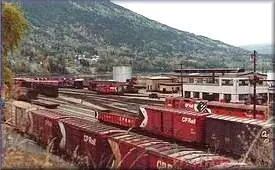 |
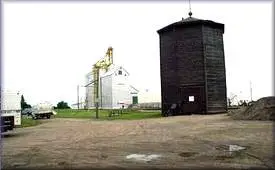 |
 |
|
|
|
|
Canadian Railway Yards,
Water Towers, Round Houses,
Control Towers and Freight
Sheds
What I am trying to do
is sepperate all these various
structures from the Station
pages
This section like the
station pages is devided into provinces or areas
Alberta
 |
 |
 |
|
|
|
|
 |
 |
 |
|
|
|
|
|
|
| This picture was taken and submitted by Massey F. Jones |
| Ogden's 75th. anniversary was held in 1988.
To commemorate the event, Odgen Shop employees decided to assemble a lasting monument. Originally called "Oggie" (for Ogden), the monument has since been renamed SPIKE. SPIKE is 27 feet tall and constructed from various pieces of
freight car and locomotive parts.
|
 |
The square water tower at Calgary's Heritage Park
still provides a steady supply for steam locomotives CP2013 and CP2014
during the Park's open season from May to September. Notice one of the
smoke plume of a steam engine in the background. The locomotive in use
that day is watered around 5:30pm, near the park's closure.
Note the wig-wag signal, featured elsewhere on these pages. The Railway Water Tower was built in 1902 and the adjacent Railway Sand House, circa 1920. |
| This picture was taken and submitted by Massey F. Jones | |
 |
The Railway Car Shop is open to the public at
Calgary's Heritage Park. It houses several preserved historic cars from the 1880s to the 1920s, with the average being from 1910. One of them can be seen just inside the open doors. Part of the turntable pit can be seen in front. |
| This picture was taken and submitted by Massey F. Jones | |
.jpg) |
Snowplow 400884 was built December 1911 in the
CP Montreal's Angus Shops and originally numbered 300884 before getting its new number in 1991. It is now displayed in Calgary's Heritage Park roundhouse, alongside a few other artifacts. |
| This picture was taken and submitted by Massey F. Jones | |
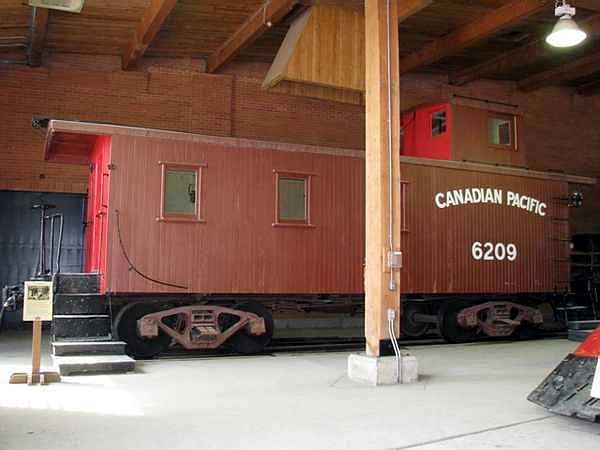 |
|
| This picture was taken and submitted by Massey F. Jones | |
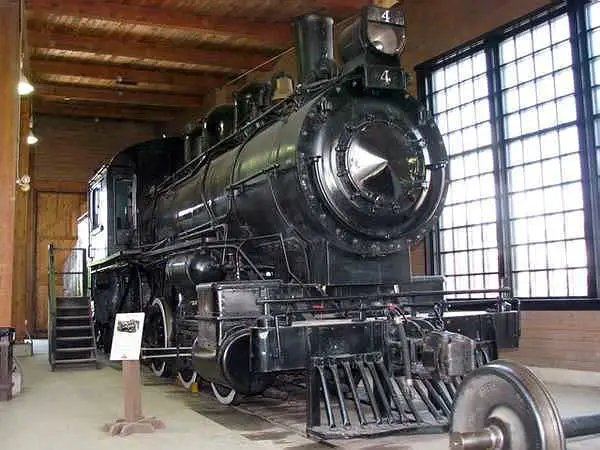 |
CP2018 on static display in the roundhouse at
Calgary's Heritage Park was built by the CPR in February 1905 (Ser#
1392). It was in service as CP2144 in 1912, then CP 6144 in 1943. It next
bit of service was at Canmore Mines (near Banff AB) as their No 4., before being acquired by Heritage Park, who converted it to diesel power. It is presumed that the nose cone is removed (for air intake) when the loco is running. |
| This picture was taken and submitted by Massey F. Jones |
 |
The Canadian Northern Railway station at 141
18 Ave SW in Calgary, after fire damage in August 1985 during renovation. Thanks to funding from The Nat Christie Foundation, the building had been totally rebuilt by 1987, as seen in a companion picture. |
| This picture was taken and submitted by Massey F. Jones | |
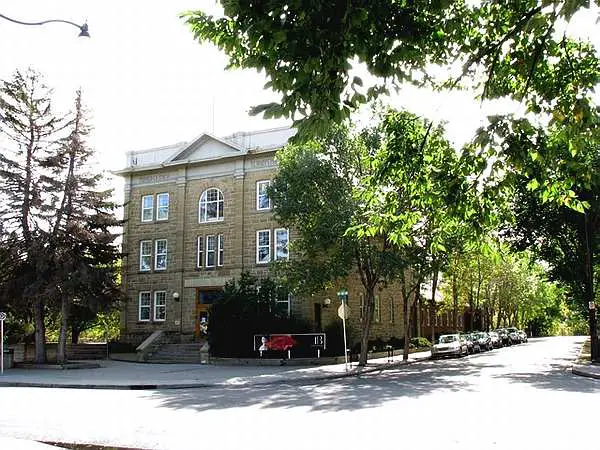 |
The Nat Christie Centre in September 2009, after
restoration |
| This picture was taken and submitted by Massey F. Jones | |
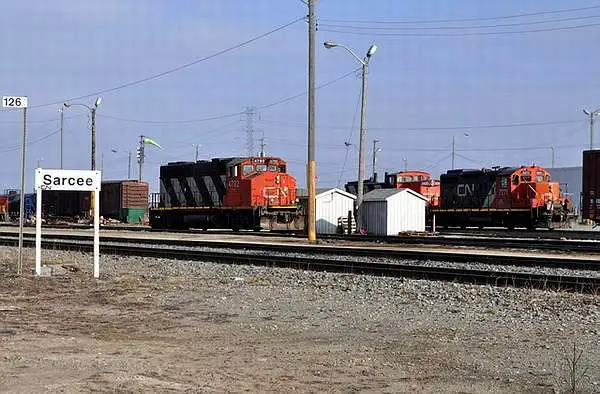 |
CN Sarcee Yard in Calgary is basically located along
50 Ave SE, between 52 St and Barlow Trail. and was
a very busy place until recently, when the railway moved its intermodal terminal to a brand new facility that they built for themselves near Conrich, north of the city on the Three Hills Sub. The new Calgary Logistics Park has according to CN, better access by road and rail. https://www.cn.ca/-/media/Files/Media/Media-News- Release/map-cn-calgary-logistics-park-en.pdf At 2:30 pm on 5 Apr 2013; we find only 3 engines
in the yard, which usually held about a half-dozen.
CN 1433 was built as GMD-1 (Ser#A1446), in September
1958 as CN 1026. It was renumbered to CN 1603 in 1988 and then to CN 1433,
as it acquired the trucks and fuel tank from CN 1134 which was scrapped.
CN 7271 is a remanufactured Geep (GP9RM) built by GM in May 1959 as CN
4239 (Ser# A1686). It now has a flashing light on top of the cab, which
means that it is fitted for
|
| This picture was taken and submitted by Massey F. Jones | |
 |
The CN Sarcee Yard in Calgary is not as busy
today, as in this view along 50 Ave SE, in the mid-1990s. This mid-day photo doesn't do the yard justice, as a long freight arrived from the East very early morning. After a brief sorting, the train departed for Edmonton and the move was reversed around midnight, with Dash 9 locomotives on the point both ways. The railway is now using their newly-constructed
|
| This picture was taken and submitted by Massey F. Jones | |
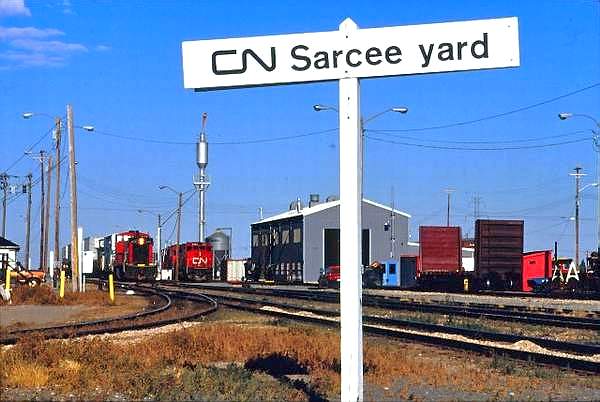 |
In busier days, Sarcee Yard saw a lot of activity
such as in this view looking east but there isn't much of it today. It is located along 50 Ave. SE between 52 St. SE and Barlow Trail. Up to about a year ago, the yard was used as a final
|
| This picture was taken and submitted by Massey F. Jones | |
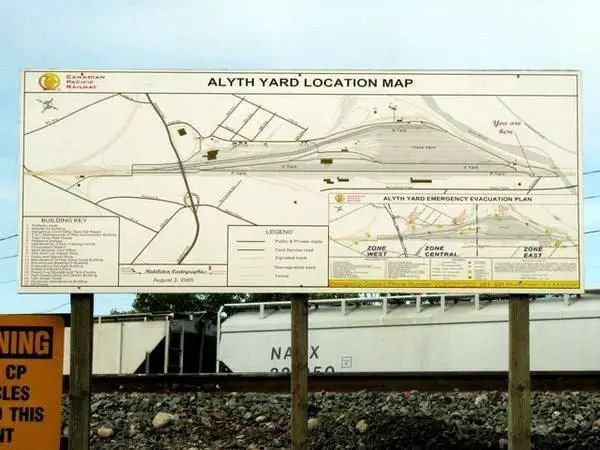 |
A layout of the various yards within the Alyth
CPR complex, gives a ready reference to employees and emergency crews. This panel one is located near the Bonnybrook Bridge. |
| This picture was taken and submitted by Massey F. Jones | |
 |
The Pulldown Tower at the CP Alyth Yard in Calgary
mid-80s.
It looks into the hump yard shown on this page. |
| This picture was taken and submitted by Massey F. Jones | |
 |
The hump yard at CP Alyth (Calgary), viewed
from the tower. A hump yard is so named because a locomotive pushes a series of cars up a slight hill, then at the top of the hump, they are released and then roll downhill on their own to a selected track. So that the cars don't run away as they accelerate downhill and and slam into one another at the end, "retarders" are used. They are those dark areas at the bottom of the picture. Each retarder consists of a series of individual piston brakes on a short section of track that grips and slows the wheels as the car rolls down the slope, bringing it down to a safe speed for coupling. The entire operation is computer controlled. View the Calgary hump yard in use
|
| This picture was taken and submitted by Massey F. Jones | |
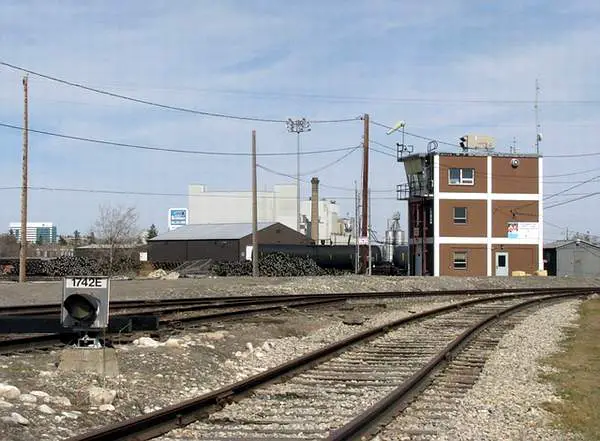 |
The 12th STREET EAST Tower is of utmost importance
in Western Canada.
It is the junction of the MacLeod and Red Deer Subs in Calgary and also controls most movements in Alyth Yard, as well as all those from Calgary to Field on the Laggan Sub (136 miles). In other words, east-west and north-south traffic. The track in front is part of a wye in and out of
|
| This picture was taken and submitted by Massey F. Jones | |
 |
A view looking southeast into CP Alyth Yard from the
12th Street Tower in Calgary, mid-80s. The gondolas in the foreground will eventually hold sulphur, a byproduct of the oil and gas industry. In the background, the container area and the chimney has since gone and the bridge in the background is Blackfoot Trail, covered on my bridge page. |
| This picture was taken and submitted by Massey F. Jones | |
 |
Looking southeast into the CP Alyth Yard during the
late-80s from Blackfoot Trail. The building to the left and the chimney have been demolished and the diesel shop in the centre, almost doubled in size. A view such as this is no longer possible, as the sidewalk from which this was taken was switched to the north (other) side during the Blackfoot Trail road reconstruction. |
| This picture was taken and submitted by Massey F. Jones | |
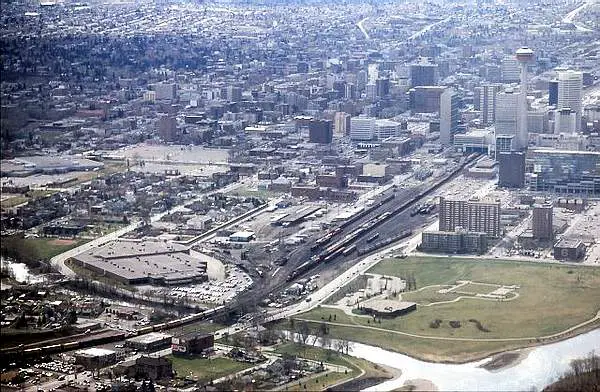 |
The CP Industrial Yard (IYO) just east of the downtown
core in Calgary, viewed from an aircraft during takeoff.
It is now closed but the area to the left of the picture (8 St SE in Inglewood) is a fair place to catch some westbound action coming out of Alyth Yard. The large building to the left is the Calgary Transit bus garage, while on the right is Fort Calgary, with the Calgary Tower to the extreme right. |
| This picture was taken and submitted by Massey F. Jones | |
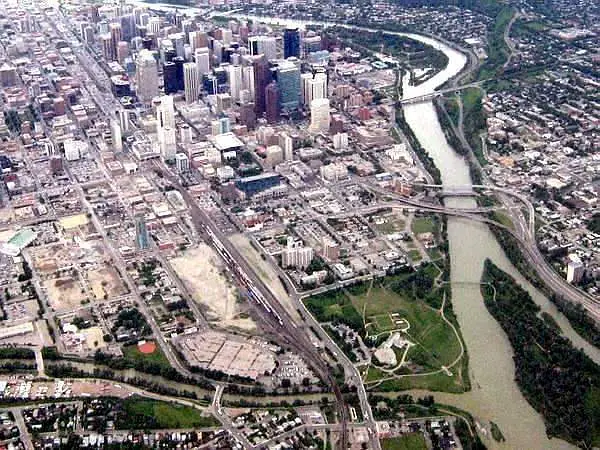 |
Another view of the CP Industrial Yard downtown
Calgary looking west, during another takeoff, on June 11th, 2007. A couple of good (but not great) spots for picture
|
| This picture was taken and submitted by Massey F. Jones | |
 |
The CPR Industrial Yard, looking east from the
Calgary Tower. The office is closed now and the area only used for emergency storage but the east-west mainline still runs through 24/7 with mile long trains and it is an important part of the system. The area where the track widens, fairly well marks the site of the first CPR station (a boxcar) in Calgary during 1883, when the construction train crossed a bridge over the Elbow River in the background (and very well shown in aerial photos). The CPR East-West mainline runs through the
|
| This picture was taken and submitted by Massey F. Jones | |
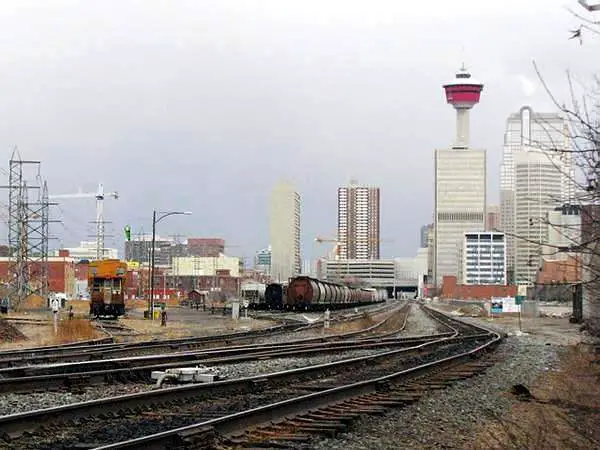 |
A ground view of the CPR Industrial Yard looking
west on March 27th 2008, from around the yard office (IYO) now closed. The Calgary Tower is in the background and Fort Calgary, across the street. The east-west mainline is in front. The right side is where a boxcar was dropped off
The next station was located between the Calgary
|
| This picture was taken and submitted by Massey F. Jones |
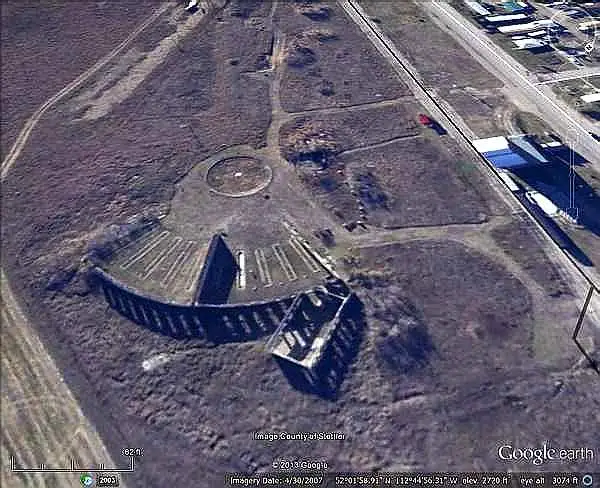 |
A "low oblique" view of the historical roundhouse
complex at Big Valley, showing the former turntable pit and stalls from
the back. Notice how large the roundhouse was.
Big Valley was an important divisional point for the Canadian Northern Railway around 1910. The CNoR got absorbed by the Canadian National Railways a bit later and Big Valley lost a bit of importance. The picture has been inverted from the original PC view to show the back of the roundhouse and now looks southwest instead of straight north. The black line is the railway (Alberta Prairie). The station is just a bit out of the picture to the centre right. More of this landmark at:
|
| Google Earth photo submitted by Massey F. Jones | |
 |
The Big Valley Roundhouse, in Big Valley, AB,
November 1989 The roundhouse ruin is on the list of Canada's Historic Places. |
| This picture taken and submitted by Massey F. Jones | |
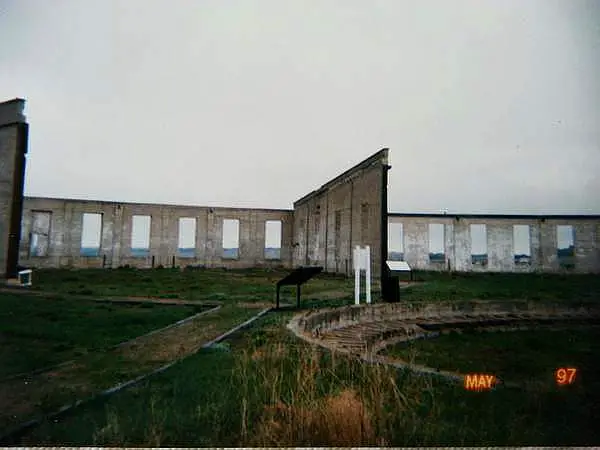 |
Another view of the The Big Valley Roundhouse,
in Big Valley, AB, taken in May 1997 |
| This picture was taken and submitted by Wayne Anderson, Lethbridge Alberta | |
 |
The old Red Deer CP Yard, looking towards the station
October 1989. The chimney in back is a local landmark (Alpha Milk).
Since this photo was taken, CP moved its yard to a
|
| This picture was taken and submitted by Massey F. Jones | |
 |
A closer view of the CP Red Deer Yard.
The mainline is about centre. At a point near the bottom of the picture, the Red Deer Sub from Calgary ends at Mileage 93.5 and the Leduc Sub to South Edmonton starts at Mileage 0.0 |
| This picture was taken and submitted by Massey F. Jones |
 |
The Edmonton CN Yard when it was in full operation
in
the downtown core,during the 60s or 70s, when this picture was taken as a colour slide with a lower priced 110 camera. The tracks were lifted to make way for the Grant MacEwan University (much of the land still remains barren) VIA moved its operation near the former Edmonton Municipal (Blatchford Field - CYXD) some 8km from city centre (12360-121 Street NW, Edmonton,AB) In the background is CN Headquarters, since
Tracks at the bottom centre of the photo may connect
|
| This picture was taken by L. Unwin and submitted by Massey F. Jones | |
 |
The CN railway line in Edmonton AB (shown in blue),
as it appeared in an inset of a map issued by the Canadian Freight Association, around the mid 70s, showing the detour which Montreal-Vancouver CN (pre-VIA) passenger trains took through downtown Edmonton. After Winnipeg, passengers traveling west took a northwesterly route through Saskatoon and Wainwright, before coming to a junction and swinging south into the downtown Edmonton Yard (City Yard) and station at the CN Tower. Upon departure, passengers proceeded north to a junction near Calder Yard (now Walker Yard) before turning west to Edson, Jasper, Prince George, Prince Rupert or Vancouver. To put it in today's context, the City Yard portion
has
The CP line is shown in red. The lower portion is the
|
| This picture was submitted by Massey F. Jones | |
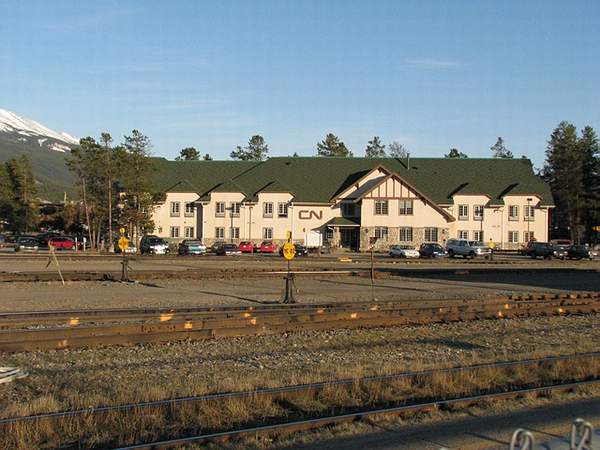 |
he CN Yard Office in Jasper, Alberta, on May 1st,
2009 from Connaught Avenue, adjacent to the VIA station at 8:15 pm. The building, situated across the railyard from
the
|
| This picture was submitted by Massey F. Jones | |
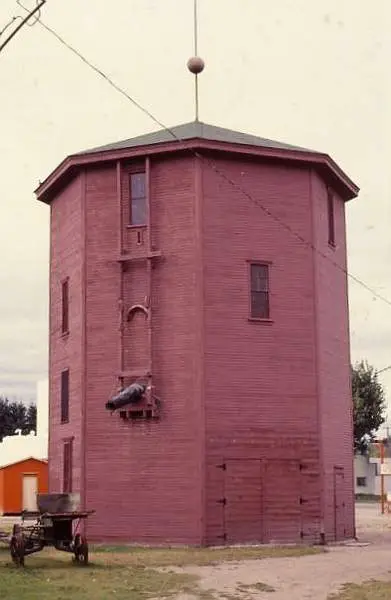 |
The
Water Tower at the Antony Hendray Museum.
Delburne
AB (near Red Deer)
This CNR tower at the Antony Henday Museum in Delburne AB accomodate railway artifacts. The
museum has fixed hours of operation in the summer
but
will accomodate appointments.
CN
metal caboose 79290 (1967) is also on the property,
along with a small rail speeder.Admission to the museum is by donation. http://www.unlockthepast.ca |
| This picture was taken and submitted by Massey F. Jones | |
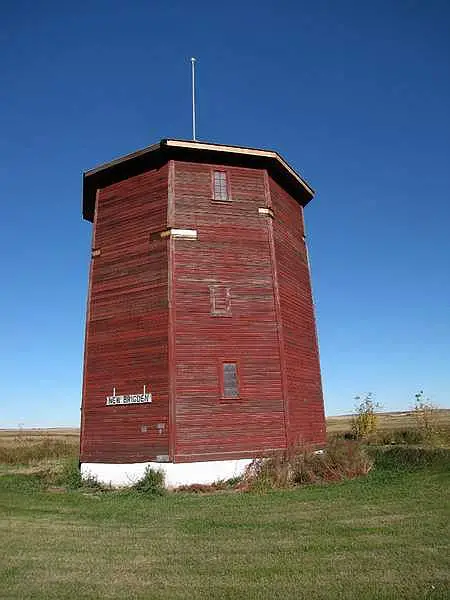 |
New Bridgen AB Water tower is located in the
town of New Bridgen |
| This picture was submitted by Dale Redekopp St. Albert, AB | |
 |
The former CN/VIA yard in downtown Edmonton,
Alberta, behind the CN Tower shown above. All the tracks were eventually removed to make way for construction of the Grant MacEwan University campus and the station located about a mile north. |
| This picture was submitted by Massey F. Jones | |
 |
These people in the picture were attending a prayer
service at the pioneer monument. They were Ukrainians as was most of the population of Willingdon at that time. The water tank was located West of the station & South of the main line Approx. 1955 |
| This picture was submitted James Booth, Willingdon AB | |
 |
The base of the above water tank
Willingdon AB, March 2007 |
| This picture was submitted James Booth, Willingdon AB | |
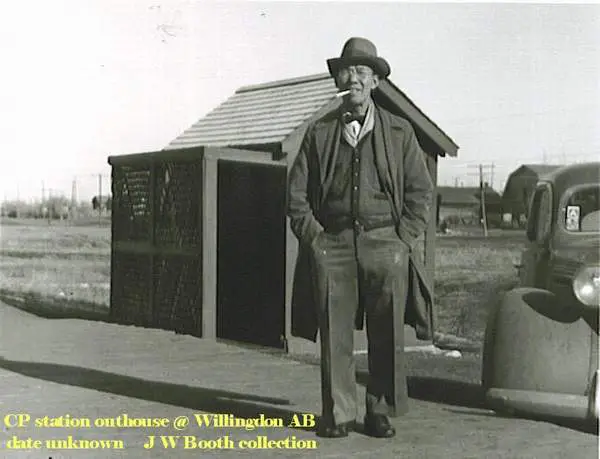 |
This outhouse was located just off the East
end of
the station platform |
| This picture was submitted James Booth, Willingdon AB | |
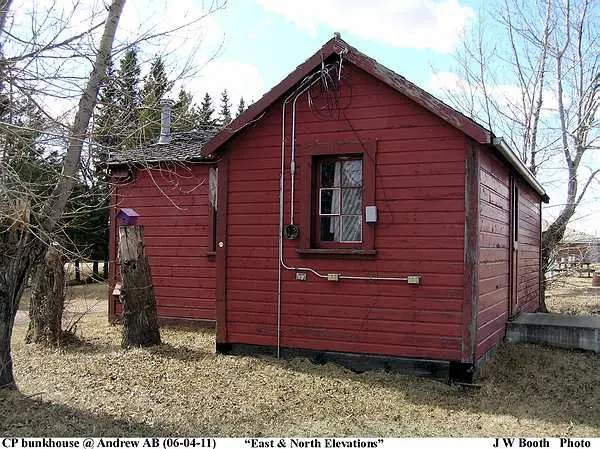 |
CP Bunk house at Andrew, AB
This building is unused. April 6, 2011 |
| This picture was taken and submitted James Booth, Willingdon AB | |
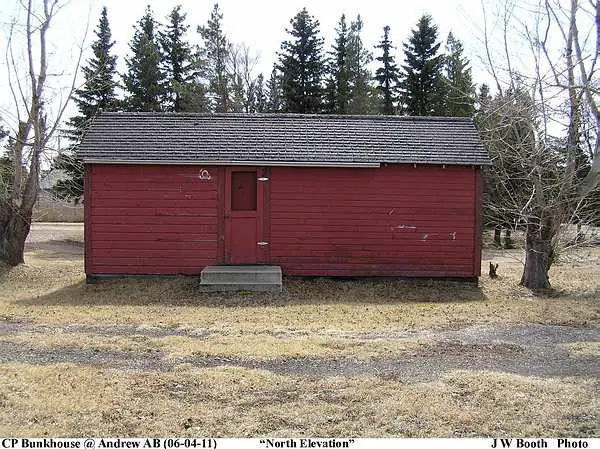 |
CP Bunk house at Andrew, AB, April 6, 2011 |
| This picture was taken and submitted James Booth, Willingdon AB | |
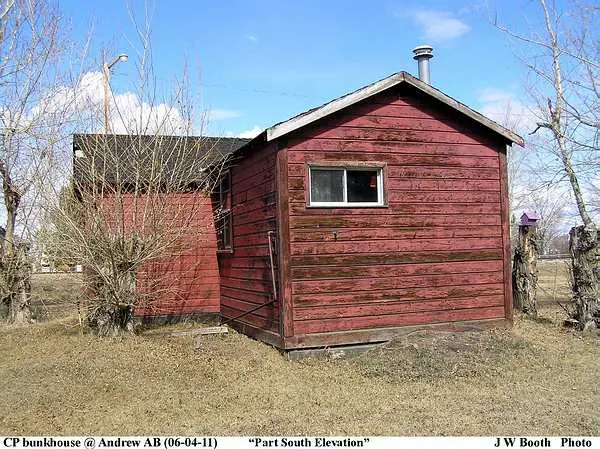 |
CP Bunk house at Andrew, AB, April 6, 2011 |
| This picture was taken and submitted James Booth, Willingdon AB | |
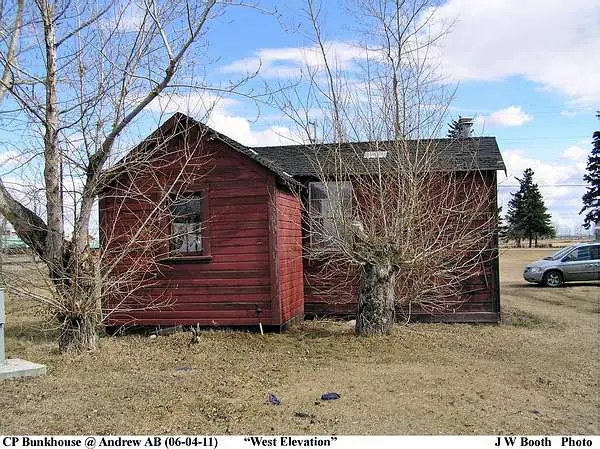 |
CP Bunk house at Andrew, AB, April 6, 2011 |
| This picture was taken and submitted James Booth, Willingdon AB | |
 |
CP Bunk house at Andrew, AB Sketch |
| This picture was taken and submitted James Booth, Willingdon AB | |
 |
C.No.R /C.N.R. freight shed, Donalda, Alberta
taken in 1997 |
| This picture was taken and submitted by Wayne Anderson, Lethbridge Alberta |
Links to other Canadian Railway Pages
| Privacy Policy for http://yourrailwaypictures.com
If you require any more information or have any questions about our privacy policy, please feel free to contact us by email at johnmd@eastlink.ca. At http://yourrailwaypictures.com/, the privacy of our visitors is of extreme importance to us. This privacy policy document outlines the types of personal information is received and collected by http://yourrailwaypictures.com/ and how it is used. Log Files
Cookies and Web Beacons
DoubleClick DART Cookie
Some of our advertising partners may use cookies and web beacons on
our site. Our advertising partners include ....
These third-party ad servers or ad networks use technology to the advertisements and links that appear on http://yourrailwaypictures.com/ send directly to your browsers. They automatically receive your IP address when this occurs. Other technologies ( such as cookies, JavaScript, or Web Beacons ) may also be used by the third-party ad networks to measure the effectiveness of their advertisements and / or to personalize the advertising content that you see. http://yourrailwaypictures.com/HSWRailway/ has no access to or control over these cookies that are used by third-party advertisers. You should consult the respective privacy policies of these third-party ad servers for more detailed information on their practices as well as for instructions about how to opt-out of certain practices. http://yourrailwaypictures.com/'s privacy policy does not apply to, and we cannot control the activities of, such other advertisers or web sites. If you wish to disable cookies, you may do so through your individual browser options. More detailed information about cookie management with specific web browsers can be found at the browsers' respective websites. |